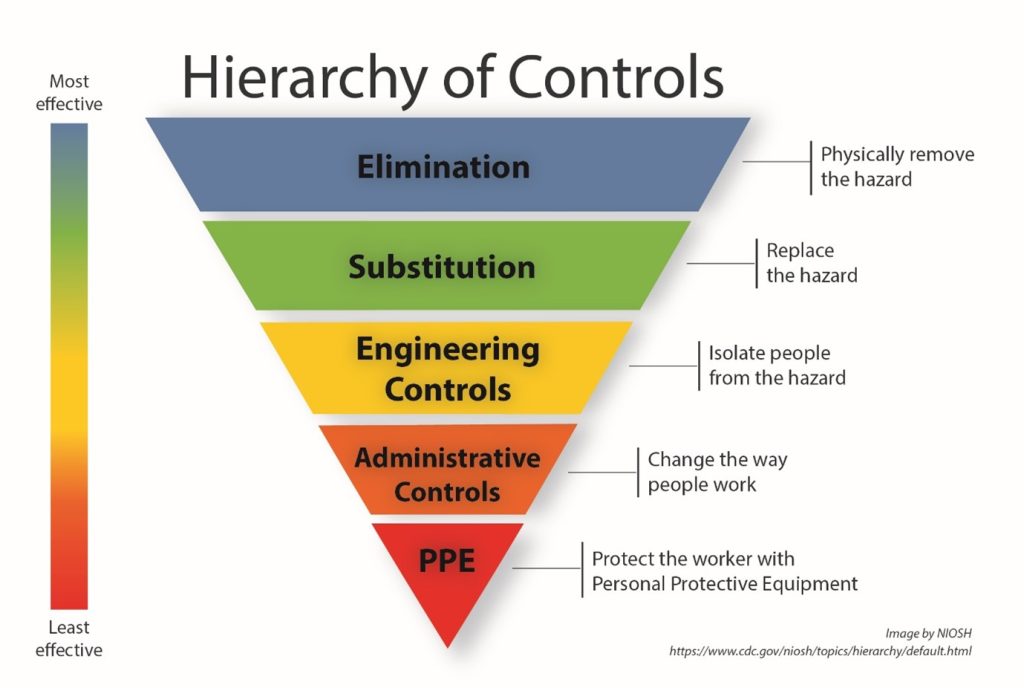In this series of 6 articles, Morag McWilliam takes a look at employees’ exposure to Respirable Crystalline Silica and who might be at risk. Morag details what employers must do to manage the health risks, control measures which should be applied, exposure limits, the use and maintenance of Local Exhaust Ventilation (LEV) systems, health surveillance, exposure monitoring and training.
Control Measures
Control measures should follow the ‘Hierarchy of Control’, concentrating on engineering and administrative controls. The sole use of Personal Protective Equipment (PPE) as a control measure is not appropriate, but its use may be considered as part of a range of control measures.

In a factory or workshop environment, the best strategy is to use engineering controls like enclosures or hoods and local exhaust ventilation to extract the contaminated air at the point it is produced or to use water suppression on fixed machinery.
Where work with hand-held power tools generates dust, for example on construction sites, the best strategies are to use localised ventilation on the tool or suppress the dust using water spray systems.
When buying or renting new equipment, make sure the controls are appropriate. High-value plant and equipment, for example the rock-drilling machines used in tunnelling or the crushing equipment operating at recycling plants, are now likely to have dust suppression integrated into the design.
Standards of housekeeping should be high. Regular cleaning should be implemented using methods such as vacuuming (with a suitable industrial vacuum cleaner – usually dust class M or H) and wet cleaning. Dry brushing must be avoided.
Other measures to consider include:
- The use of materials with a lower content of hazardous material. – Remember, if you are using a material with 70% silica content, then the Respirable Crystalline Silica generated from cutting will also be 70%.
- Enclosing the task where possible and applying Local Exhaust Ventilation (LEV)
- Controlling dust emission at source by use of water suppression, LEV or both.
If this control measure is selected, it is important to ensure that pre-use checks of tools include checking that the water attachment inlet is functioning effectively and has not become blocked by any process debris.
If water suppression is by means of recirculated water, a programme of regular checks and maintenance should be implemented to ensure that conditions control the growth of bacteria including Legionella. Risk factors include the temperature of the water (20-45 degrees C.,) the dirtiness of the water and the extent of agitation. Methods to control the risk factors include regular changing of the water, cleaning the reservoir and the proper use of biocides.
- The use of low-energy tools for cutting e.g. a guillotine rather than a cut-off saw.
- Cutting hazardous materials to size off-site where it may be easier to implement effective engineering control measures.
- Segregation of high-risk processes such as pneumatic chiselling, cutting and polishing from the general work area. Examples of means of achieving this include restricting access to authorised personnel only, the use of fixed screens where power tools are being used, and sequencing of work to minimise the number of other workers on site when hazardous materials are being processed.
If it is necessary to use vehicles such as earth movers and tractors etc during activities involving hazardous materials, the following measures should be considered:
- Use water (e.g. from a bowser) to dampen down road surfaces to minimise dust generation.
- Select a vehicle that has an appropriate enclosed ventilated cab fitted with suitable filtered air intake.
- Ensure a comfortable working environment for the operator. Where appropriate, provide air conditioning to reduce the likelihood of the windows being opened.
- Use high-efficiency particulate filters and pre-filters on the air intake to stop dust from getting into the cab.
- Ensure the cab door and windows are always closed except during entry and exit.
- Use radios, closed-circuit television (CCTV), public announcement (PA) or a suitable communication system to prevent the need for the driver to open the cab door/window to communicate with colleagues.
- Provide facilities for the worker to minimise the transfer of contamination into the cab from personal protective equipment and workwear.
In practice, it is likely that a combination of some of the control measures described above will be needed to ensure adequate control of exposure.
This is the third in a series of articles about raising awareness of the dangers of RCS, you can catch up on parts one and two here. The next article looks at what is classed as adequate control and exposure limits. If you would like to talk further please email [email protected].


